This was a research project for Bournemouth University, this project was supposed to act as a simulation of the pre-visualisation task before beginning a project.
Introduction
Action and Adventure is one of the largest Genre’s within the Cinematic world in terms of Box Office return . Furthermore, Adventure can be found in the top 3 of all major gaming platforms . As such, it makes sense to analyse the core of these genres, weaponry. In this article, I intend to focus upon melee weaponry as I find that these offer a healthy balance between animation potential, efficiency to craft and creative possibility. Specifically, I intend to study the various versions of the sword, due to the well established symbolism associated with the various types of within the current media.
The idea of blades being able to invoke a specific view or feeling is well established within the media world, to the point where the mere concept of a sword and its apparent popularity within media is itself constructed by the media. Within historical times (I will largely be referring to the Medieval era), swords were pretty much exclusively wielded by kings and rulers because of the fact that they were exclusively tools for fighting and served no secondary purpose. Thus, they were extremely rare and more commonly symbolic rather than a common use tool which everyone would have known how to use.
Within this, it is my intention to establish a set of symbolisms that a given weapon can portray, and then use photography to successfully capture these symbolic features. Thus, allowing me to reproduce such work in Computer Graphics that would allow swords to contribute actively to the narrative, as a posed to being passive actors. This means I wish for swords to be able to contribute to a scene in their own right, without the outside influence of other factors such as a character or location. The weapon will, itself, be an actor within the scene which contributes to the narrative.
All swords can be broken down into 3 basic components:
-
A sharp blade which will be used to strike against targets / parry incoming attacks. (see figure 1).
An optional cross guard which blocks an incoming strike from hitting the hand of the wielder. Sometimes also referred to as a handguard or crossbar. (see figure 2).
A handle with a size relative to the size of the blade - in units of the size of the hand of a human. (see figure 4).
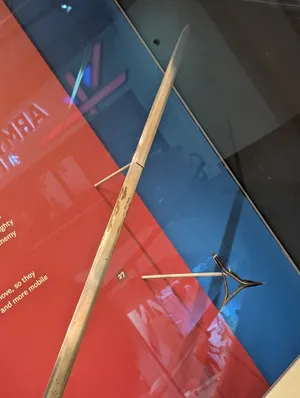
The blade of a one-handed longsword.
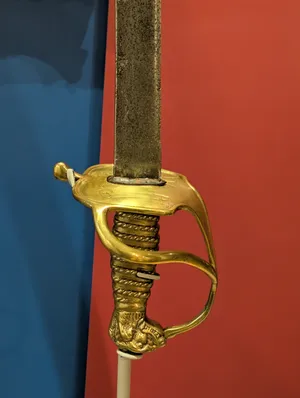
The golden crossbar of a saber.

The handle of an ornate shortsword.
The sword blade can feature one sharpened edge or two. The two-sided blade offers an obvious offensive advantage because of the added flexibility of its attack. But, this must be balanced with the idea that the blade will therefore require double the maintenance to ensure the blade is properly sharpened, as well as also requiring the blade to be wider. When an object cuts, it uses the sharpened section of the blade to initially separate the object. The width of the blade is then used to push the two new parts further apart and ensure a full cut. This then maximizes blood loss and therefore damage to the target. The effect of blood loss can then be exemplified by placing a small slit in the centre of the blade for blood to run down (see figure 8).
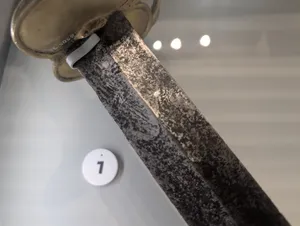
A closeup of the blade showing a crease where the rising parts of the blade meet.
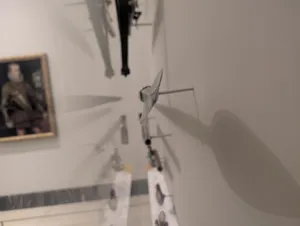
The side of a spear to show the slope effect.
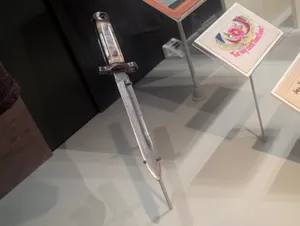
A dagger with a slit through which blood can run after stabbing a person to enable a person to more effectively bleed out without having to remove the knife.
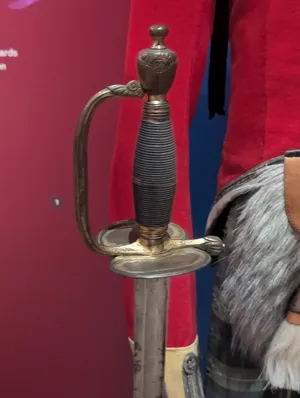
The crossbar of a sabre.
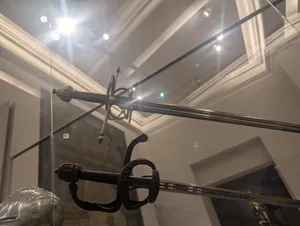
The crossbars of 2 rapiers.
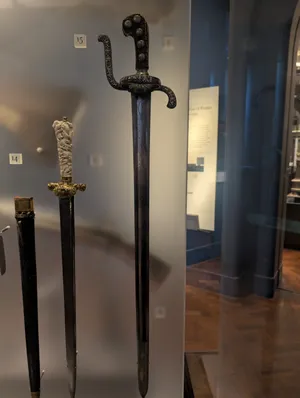
The crossbar and basic handguard of a sabre.
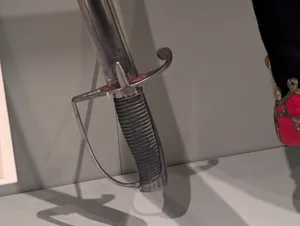
The crossbar and handguard of a sabre.
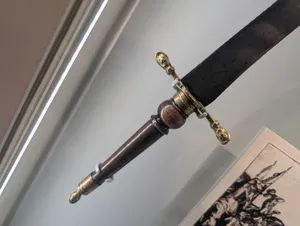
The crossbar of a dagger.
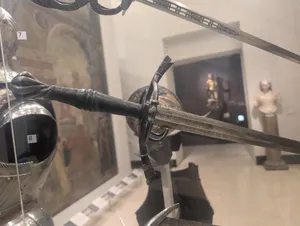
The crossbar of a longsword.
Swords in the media
As mentioned in section 1, Films and Video Games that feature melee weaponry are often some of the most popular. Here I will go over a few and their use of these weapons:
For Honor
(). For Honor is a multiplayer fighting game known for its mechanics around stances, allowing any character to hold their weapon in one of three possible stances. An important thing to note for this game is the idea that the weapons are specific to a character - a character who supposedly has specific training, holds specific armour and has specific abilities. This, therefore, implies that these weapons are a part of the characters identity and representation the same as any other aspect. This then presents the idea that weaponry is capable of expressing a specific idea or symbolism, an idea that is found throughout other media.
The Elder Scrolls V: Skyrim
r0.25
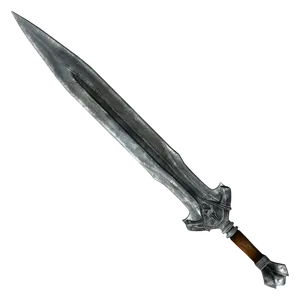
image
(). Skyrim is a Role Playing Game set in a fantasy setting of its namesake - within the world of Tamreil. This game features multiple different types of sword including the sword, longsword and greatsword. However, I feel the most important to note is the first sword encountered by the player in the game - the Imperial sword. At the beginning of the game, the player is given a choice to join either the imperial legion or the stormcloak rebellion. The given weapon of the stormcloaks is an axe - typically associated with Viking culture and a brutish mentality which then helps to contrast against the weapon given by joining the imperials, which then helps to give an impression of legality and structure. Such being the common representation of the sword.
The Lord of the Rings
(). The Lord of the Rings is both a book and film series set in a medieval fantasy world. Being the generic conventions of the fantasy genre, these feature many different types of swords and blades. The most notable being the dagger held by Bilbo - one of the few magical weapons in the series as well as the longsword held by Aragorn.
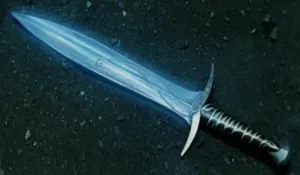
The blade 'Sting' from the film 'The Hobbit' glowing in the presence of orcs.
Pirates of the Caribbean
() The Pirates of the Caribbean is a film series following the exploits of pirate Jack Sparrow and the other pirates and sailors he encounters on his journeys. These feature 2 main types of sword, the sabre and rapier. There is a running joke within the series that concerns a particular sword: A rapier produced by the character William Turner for the Commodore James Norrington. The joke runs that anyone who sees the sword and has a chance to examine it states “nice sword” before taking it. This aligns with the representation of the rapier being an example of regality.

The 'nice sword' crafted by William Turner for Commodore James Norrington
How I met your Mother
() The show how I met your mother is comedy series in which the protagonist Ted Mosby tells the story of how he met his mother to his children. The comedy series may appear to be a strange choice for this, however, this show features 2 sabres which are decorative items hung on the wall of their flat. This fits the general symbolic association of the sabre, that it is a largely decorative piece. However, in the Season 1, Episode 8, entitled “The Duel”, Ted and his friend Marshall actually use these swords to duel , such that they fulfil Chekhov’s Gun and allow these weapons to generate their own symbolism through their use, that of their own friendship.
Ghostrunner
() Ghostrunner is a fast-paced game in which a cyborg wielding a katana must run through a cyberpunk city while slashing at enemies with guns. This game is an expert at presenting the katana and showing its intended use. The concept of the katana is that it can be swung fast and allows for quick movement - almost a merge between the rapier and the longsword. Although it is worth noting that this representation from Ghostrunner is largely due to the way that the weapon is wielded and used in the game, rather than its design and structure. However, recognising this is still useful for the establishment of a base case, from which my own research can build from.
Ahsoka
() Ahsoka was a series set in the marvel universe, following the journey of Ahsoka Tano after the events of order 66. The character of Ahsoka can be seen to hold 2 separate types of lighsaber - which each have a comparable type of sword. In 1 hand she holds what is referred to as a “shinto-blade”, a lightsaber equivalent of a shortsword. As well as a normal lightsaber, the equivalent of a longsword. She holds an extremely acrobatic style of fighting with these 2, allowing herself to act more defensively from 1 hand and more offensively from the other. Overall, balancing the drawbacks of 1 blade with the positives of another.
The show also features an antagonist named Baylan Skoll. This character wields a large lightsaber which is treated with the same fighting style of a greatsword. This contrast of Ahsoka’s agility against this type of weapon is excellent at displaying the various representations of weapons as Ashoka uses short quick attacks while dodging out of the way of Baylan’s strong attacks while he himself blocks Ahsoka’s own attacks.
Iterations of Sword Symbolism
Iteration of dull sabres
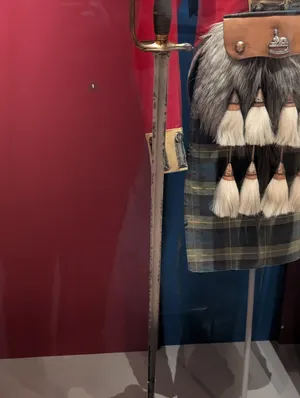

The first 2 blades featured in figures 18 and 20 features a dull, steel-like metal blade with 2 sharp edges, a basic circular hand guard and an uninteresting handle. These weapons are not being held in any way. As a result, these blades are rather unimpressive such that they fail to convey any particular element of story or narrative - such being my final goal. The only characteristic these blades could be said to have is a slight damage to the blade, suggesting age or lack of care. Thus the blade is unable to present a narrative or function as a narrative device. To improve, the blades should feature some form of interesting shape, colouring or iconography.
Iteration of an engraved sabre
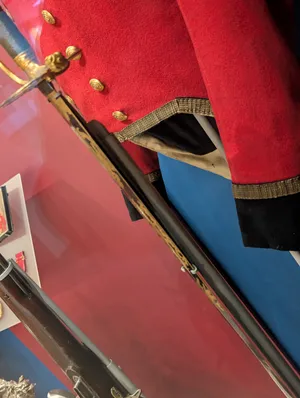
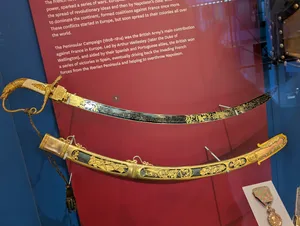
The images in figures 21 and 23 are arguably the inverse of the iteration in section 3.1 in terms of the presence of iconography. The blade features a dragon as a cross guard and a lions head on the end of the handle. There is also a paragraph of inscription on the blade as well as many pieces of iconographic art decorating the blade. All of which creates an overwhelmingly regal appearance. It is obvious that this weapon was only meant to be simply a display piece. This is one of my issues with it. Chekhov’s Gun suggests that a gun featured in a scene should be fired. Thus, it follows that a sword in a scene must be used in a battle. This blade not being able to be used in battle would therefore limit its narrative potential to an extreme level as it is unable to be used in a battle, and therefore cannot actively contribute to the narrative, only passively. My goal being weapons that can be used to add to the narrative in their own right, requires weapons that can, in fact, add to the scene.
Furthermore, I feel that while the elaborate design is successful in adding a regal element to the blade, it is simply too much. The dragon and lion plus the paragraph plus the patterns on the blade is simply too much. It overwhelms the eye which in turn, would cause it to be less effective at conveying narrative in animation - a visual medium.
Overall, what can be learned from this iteration is that the weapon must appear actively useful for fighting and combat, as well not being too visually overwhelming. It must be sensible in its design while still being interesting.
Iteration of a damaged blade
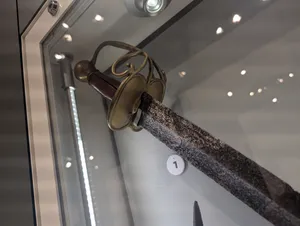
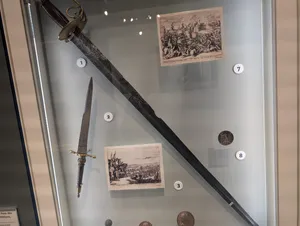
Figures 24 and 26 are much closer to achieving my goals. The blade itself features damage to the shape, allowing the silhouette to be effected, this is probably the most obvious narrative element of the blade, showing age and use. The colouration of the blade is also additive to the overall narrative appeal of the weapon as its damage furthers the concept of age and well use. Overall, the blade is very good at displaying a narrative concept within its own right.
Iteration of carved longswords
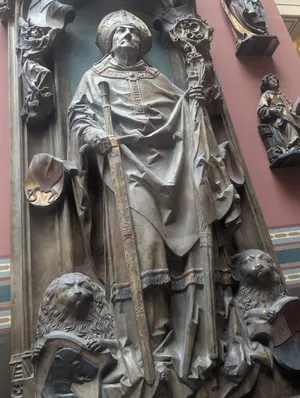

The images in figure [fig:Iteration4] are from 2 separate stone carvings. Figure 27 is from a larger than life statue (around 9 feet tall) while figure 29 is a minifigure in a nativity-esque crucifixion scene. I believe the fact that both statues feature longswords being held by a character (both slanting slightly to the left) would allow itself to create a narrative concept. The fact that the blade is being held means it does not lack the effects of Chekhov’s Gun as it is still being used in an active situation (even if not being fought with, it is an active element in the scene). Keeping it in the scabbard would allow it to present the idea of potential, the mystery acting as a hermeneutic code which is an advanced narrative technique to keep an audience interested in the potential of a narrative by obscuring information.
Another strong feature of this iteration is the use of the various associations of the longsword. The longsword holds a symbolism of honour and strength. Thus, the sword being wielded by a religious figure or knight in the presence of Christ would contribute greatly to the overall intention of the sculptures (such intention being to imply the strength and power of Christ). The fact that these stand-alone pieces of art are using weapons in the same ways that I have described previously to present this representation and interpretation is immensely powerful and important for helping to prove my goal of allowing weapons to contribute to a narrative in ways other than simply slicing and damaging opponents.
The only downside of these pieces is that they are indeed carved from stone rather than forged of metal. Thus meaning that they are struggling to inform the creation of materials to provide narrative clarity. However, other iterations (mainly section 3.2) more than compensate for this, providing information to help rectify this otherwise singular lacking in this iteration.
Overall I feel that this iteration is incredibly strong despite its lack of material diversity, as it shows the generic symbolism of the chosen weapon in action, allowing it to clearly present the concepts associated with it. Furthermore, it works with advanced narrative theories to help build its narrative strength. Overall, creating a rather useful example to demonstrate the ability of blades to contribute to the narrative of an art piece.
Iteration of the Holy Longsword
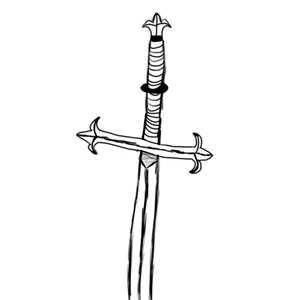
image
The drawing in figure 30 features the handle and crossguard of a longsword. The handle features a split to separate where 2 hands should be placed while wielding the weapon. Furthermore, the pummel of the handle and the cross feature a pattern commonly found on a catholic cross, with the overall shape and relative proportions of the handle and cross work to further this iconography of that of a catholic cross. This representation of religion works exceptionally well when combined with the common associations with that of a longsword as both have the capacity to represent strength and power, as well as honour. Thus making this quite a useful piece to analyse in relation the narrative capabilities of a weapon. The active capabilities of the longsword - that the weapon offers a balance between offence and defence - is further exemplified by the separator on the handle, such that the weapon is clearly designed to be wielded by 2 hands. This approach would offer more strength while fighting but would prohibit the use of a shield. Thus, requiring the wielder to put their whole faith in their sword, such making it appear extremely strong. This clear representation in such subtle details is incredibly useful and powerful within the narrative, thus helping to demonstrate methods in which a blade is able to strongly contribute to the narrative.
Iteration of the Ravenous Dagger
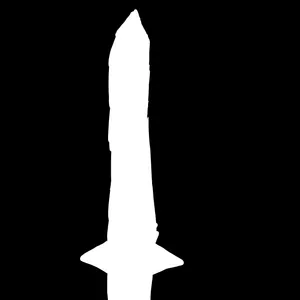
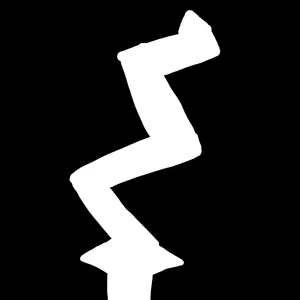
The figure [fig:Iteration7] is in fact demonstrating two possible states of a magical dagger. Figure 31 shows the dagger in its pre-thrust state, while figure 33 shows the dagger post-thrust. The concept behind it is that the weapon will change shape after “tasting” blood such that when it is removed from the target, the zigzag shape of the blade will give the same effect as that of teeth on a blade, dealing more damage to the opponent . This weapon design is very interesting as I have not touched the concept of magical weapons much as of yet (except in section 2.3). The concept of magic fits extremely well with the dagger as well as the concepts of bloodiness and danger, thus this weapon works quite well to contribute to the narrative. However, the pitfall of this is that its effect is dependent on its use. This essentially means that its ability to contribute to the narrative is dependent upon an actor’s own contribution to the narrative. A member of the audience would not be able to gleam anything about the events of the story from the dagger, without its use by another person. Therefore, while the concept of the weapon is highly intriguing, it ultimately fails in its ability to actively contribute to a narrative.
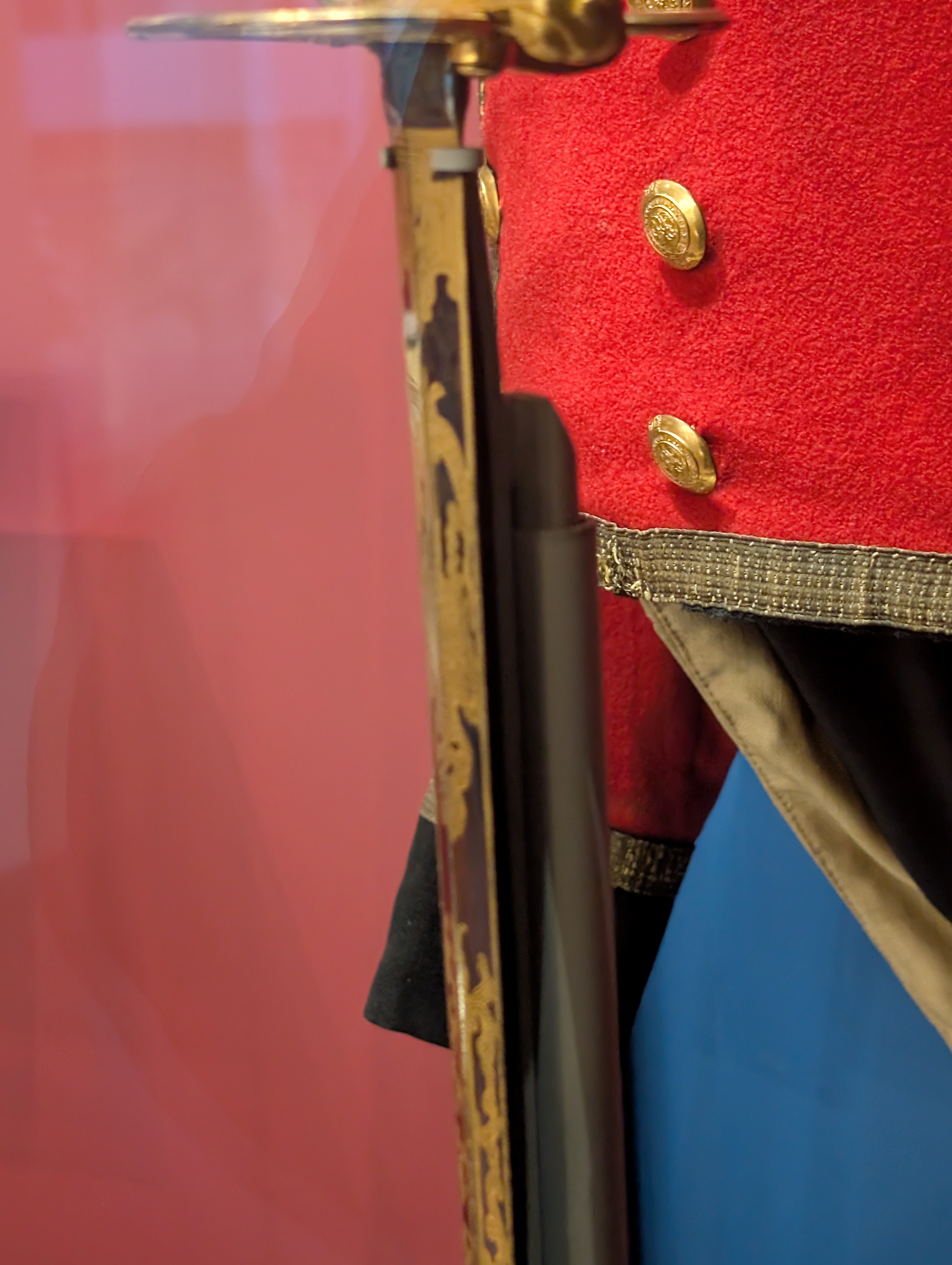 A Study on Swords
A Study on Swords Database Portfolio
Database Portfolio Decision Maker
Decision Maker Drawing Project
Drawing Project Early Labour App
Early Labour App Floating Island
Floating Island Jeremy The Rat
Jeremy The Rat MaebeeTV Discord Bot
MaebeeTV Discord Bot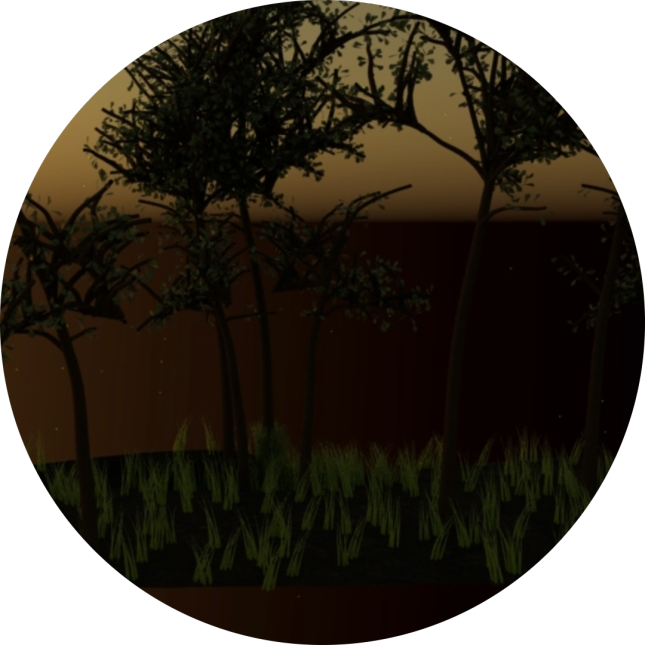 Maya Forest Generator
Maya Forest Generator Super-pixel Importance Sampling
Super-pixel Importance Sampling Sweet N Soft tech
Sweet N Soft tech TMDB Access Library
TMDB Access Library The Forest
The Forest Vernos Langathripoodinary III
Vernos Langathripoodinary III